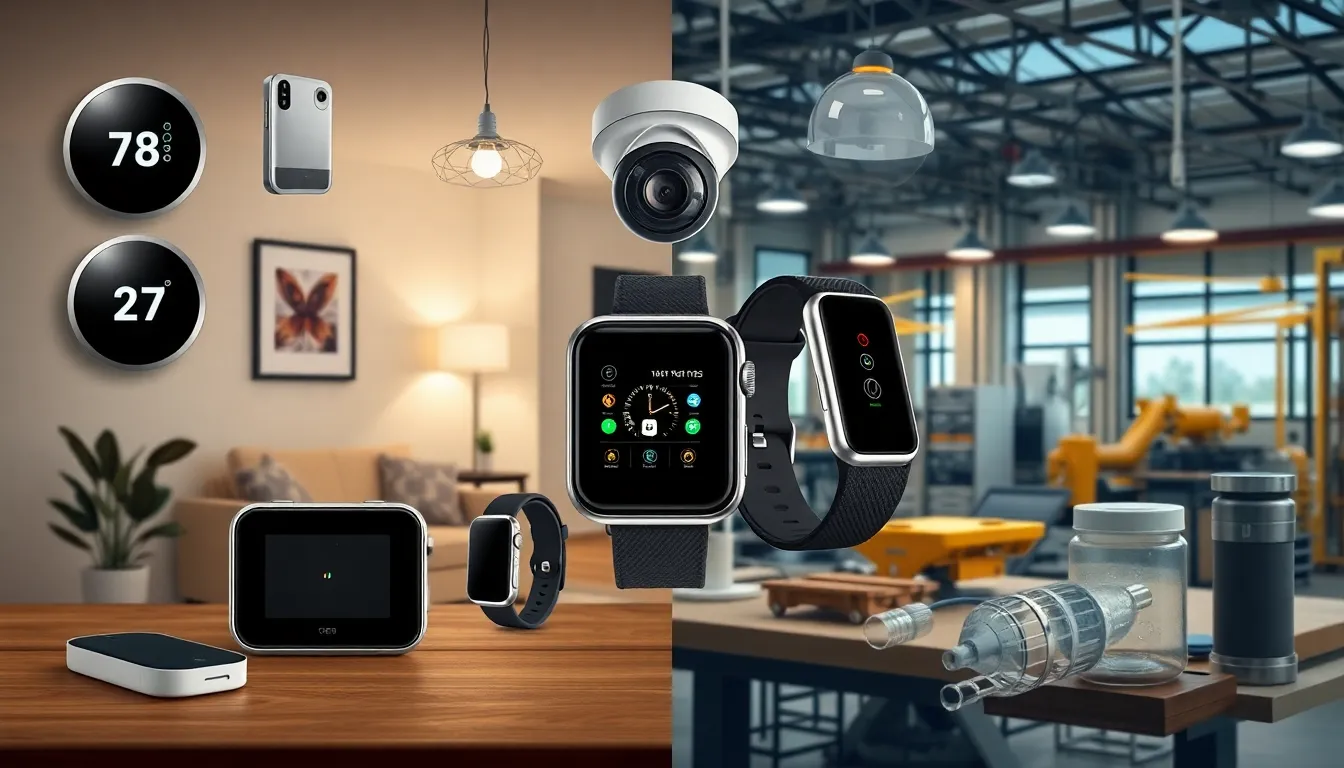In today’s fast-paced world, connected devices have transformed how people interact with technology. From smart home gadgets to wearable fitness trackers, these devices are woven into daily life, enhancing convenience and efficiency. The Internet of Things (IoT) has paved the way for seamless communication between devices, creating a network that simplifies tasks and improves overall productivity.
As more households embrace smart technology, understanding the implications of connected devices becomes crucial. They offer not just convenience but also raise questions about privacy and security. By exploring the landscape of connected devices, individuals can make informed choices that enhance their lives while navigating the challenges that come with this technological evolution.
Table of Contents
ToggleOverview of Connected Devices
Connected devices refer to electronic gadgets that communicate over the Internet or other networks. These devices include smart home products like thermostats, lights, and security cameras, as well as wearable technology such as fitness trackers and smartwatches. The integration of these devices into everyday life enhances convenience and promotes efficiency.
Types of Connected Devices
- Smart Home Devices
Smart home devices automate and control household functions. Examples include smart speakers that play music or manage schedules, smart locks enhancing security, and smart refrigerators that track inventory.
- Wearable Technology
Wearable technology monitors health and fitness metrics. Fitness trackers record steps, heart rate, and sleep patterns. Smartwatches extend connectivity by enabling calls and notifications from smartphones.
- Industrial IoT Devices
Industrial IoT devices streamline efficiency in manufacturing and production. Examples include sensors that monitor machine performance and automation tools that enhance productivity.
- Connected Cars
Connected cars improve safety and driving experiences. Features include navigation systems that provide real-time updates and telematics systems that track vehicle conditions.
Benefits of Connected Devices
- Increased Convenience
Connected devices simplify daily tasks, allowing for remote operation and automation. Users control home environments or access health data effortlessly.
- Enhanced Data Utilization
Data collected from connected devices provides insights into user habits and patterns. This data can improve personalized experiences and inform future decisions.
- Improved Efficiency
Automation increases efficiency in both personal and professional settings. Smart devices optimize energy usage, reduce waste, and streamline workflows in various sectors.
- Remote Monitoring
Remote monitoring capabilities allow users to manage devices from anywhere. For instance, individuals can monitor their homes or health metrics without being physically present.
Challenges of Connected Devices
- Privacy Concerns
Connected devices can lead to potential privacy risks. Data shared across networks may become vulnerable to unauthorized access or leaks.
- Security Threats
Security threats from hacking or malware pose risks to users. Robust cybersecurity measures are essential to protect connected ecosystems.
- Interoperability Issues
The lack of standardization among devices may create compatibility challenges. Users might encounter difficulties when integrating various products from different manufacturers.
Connected devices represent a significant evolution in technology, driven by the Internet of Things. Understanding the types, benefits, and challenges associated with these devices can help end-users navigate this growing landscape effectively.
Types of Connected Devices

Connected devices encompass a variety of technological innovations, each serving distinct functionalities across different sectors. The following subsections outline key categories of connected devices.
Smart Home Devices
Smart home devices automate household tasks, enhancing convenience and efficiency for users. These products include smart thermostats, smart lights, and smart security cameras. Smart thermostats like the Nest Learning Thermostat optimize energy usage by adapting to user preferences. Smart lights allow users to control brightness and color remotely, contributing to personalized ambiance. Smart security cameras provide real-time monitoring and alerts for enhanced home security.
Wearable Technology
Wearable technology monitors health metrics and promotes fitness awareness. Common examples include smartwatches, fitness bands, and health monitors. Smartwatches, like the Apple Watch, track heart rate, sleep patterns, and physical activity levels. Fitness bands, such as the Fitbit, focus on step counting and activity reminders. Health monitors, like continuous glucose monitors, offer real-time health data for users managing chronic conditions.
Industrial IoT Devices
Industrial IoT devices optimize operations in manufacturing and logistical environments. Key examples consist of smart sensors, connected machinery, and asset tracking systems. Smart sensors monitor equipment performance, reducing downtime through predictive maintenance. Connected machinery enables remote operation and real-time data analysis. Asset tracking systems enhance supply chain efficiency by providing up-to-date information on product locations.
Benefits of Connected Devices
Connected devices offer significant advantages in various aspects of daily life, enhancing both convenience and efficiency while providing valuable data insights.
Convenience and Efficiency
Connected devices streamline everyday tasks, allowing users to manage multiple functions from a single interface. Smart home gadgets, such as thermometers, lights, and security systems, can be controlled remotely through smartphones. This capability enables users to adjust settings from anywhere, enhancing energy management and ensuring security.
Automation plays a crucial role in efficiency. For instance, connected appliances can preheat ovens or send alerts when laundry finishes, saving time. Additionally, in industries, connected machinery improves workflow by automating repetitive tasks, reducing the potential for human error. With all these features, connected devices transform mundane activities into easier, quicker processes.
Data Collection and Analysis
Data collection and analysis is a prominent benefit of connected devices. Wearable technology, such as fitness trackers and smartwatches, continuously monitors health metrics like heart rate, sleep patterns, and physical activity. This real-time data aids users in making informed health decisions and tracking personal progress over time.
In industrial settings, connected devices gather extensive operational data. This data enables predictive maintenance, identifying issues before they escalate into costly failures. Businesses leverage analytics for improved decision-making, optimizing supply chains and resource allocation. Enhanced data usage leads to better insights, driving innovation and efficiency across sectors.
Challenges Faced by Connected Devices
Connected devices face several significant challenges that impact their functionality and user experience. Key issues include security concerns and interoperability problems.
Security Concerns
Security concerns present a major challenge for connected devices. Cyber threats, such as hacking and data breaches, can compromise personal information and device functionality. According to a report by Cybersecurity & Infrastructure Security Agency, 75% of IoT devices lack adequate security protections. Vulnerabilities in device firmware often allow unauthorized access, leading to potential exploitation. Ensuring robust security measures, including encryption and regular software updates, helps mitigate these risks. Users must remain vigilant, using strong passwords and enabling two-factor authentication to protect their connected devices.
Interoperability Issues
Interoperability issues hinder the seamless integration of connected devices from different manufacturers. Various protocols and communication standards create barriers, limiting compatibility and user experience. For instance, smart home devices may utilize different platforms that do not communicate effectively with one another, leading to fragmentation. A study by the International Telecommunications Union indicates that 40% of consumers encounter device compatibility issues. Standardizing communication protocols and adopting universal frameworks can enhance interoperability, enabling devices to work together fluidly and improving overall system efficiency.
Future Trends in Connected Devices
Connected devices continue to evolve, driven by advancements in technology and increasing consumer demand. Several trends are emerging in this dynamic landscape, shaping the future of connected devices.
1. Increased Integration of Artificial Intelligence
Artificial intelligence (AI) increasingly powers connected devices, allowing for smarter functionalities. Devices can learn user preferences and behaviors, leading to more personalized experiences. For instance, smart thermostats can self-adjust based on historical data and climate patterns, optimizing energy efficiency while enhancing comfort.
2. Emphasis on Security and Privacy
Security and privacy remain top priorities as connected devices proliferate. Manufacturers are focusing on implementing advanced encryption, multi-factor authentication, and regular software updates. By addressing these concerns, they aim to protect user data and build trust in their products, ensuring a safer IoT ecosystem.
3. Growth of Wearable Health Technology
Wearable health technology is witnessing significant growth as consumers prioritize health and wellness. Devices like smartwatches and fitness trackers now incorporate advanced health metrics, including blood oxygen levels and sleep quality. This trend enables users to monitor their well-being and encourages proactive health management.
4. Expansion of Smart Home Ecosystems
Smart home ecosystems are expanding, with a growing number of interconnected devices available. Home automation solutions today include smart appliances, security systems, and lighting that can communicate with one another. This interconnectedness enhances convenience, allowing users to create customized environments.
5. Focus on Sustainability
Sustainability has become a crucial focus in the development of connected devices. Manufacturers are adopting eco-friendly materials and energy-efficient designs to meet consumer demand for environmentally conscious products. For instance, smart energy management systems help reduce energy consumption and carbon footprints.
6. Accelerated Adoption of 5G Technology
The rollout of 5G technology significantly impacts connected devices, providing faster data transmission and lower latency. This advancement allows for real-time communication among devices, making applications like smart cities, autonomous vehicles, and augmented reality more feasible and efficient.
7. Interoperability and Standardization Efforts
Interoperability is critical for the seamless integration of connected devices. Industry stakeholders are pushing for standardization to eliminate compatibility issues. Initiatives like Matter aim to unify communication protocols, allowing devices from different manufacturers to connect and operate smoothly within an ecosystem.
8. Rise of Edge Computing
Edge computing is gaining traction, enabling data processing closer to the source rather than relying solely on cloud-based solutions. This reduces latency and enhances performance for connected devices, particularly in applications requiring quick decision-making, such as autonomous vehicles and industrial automation.
These future trends underscore the ongoing evolution of connected devices, shaping how individuals interact with technology and the environment around them. As advancements continue, addressing security, privacy, and interoperability will remain vital for sustaining growth in this sector.
Connected devices are reshaping how individuals interact with technology in their everyday lives. They offer unparalleled convenience and efficiency while also presenting challenges that require careful consideration. As these devices become increasingly integrated into homes and industries, understanding their implications is essential for users.
With advancements in AI and a focus on security and interoperability, the future looks promising. Embracing these technologies can lead to smarter living and improved decision-making. Staying informed and vigilant will help individuals harness the full potential of connected devices while mitigating risks.



